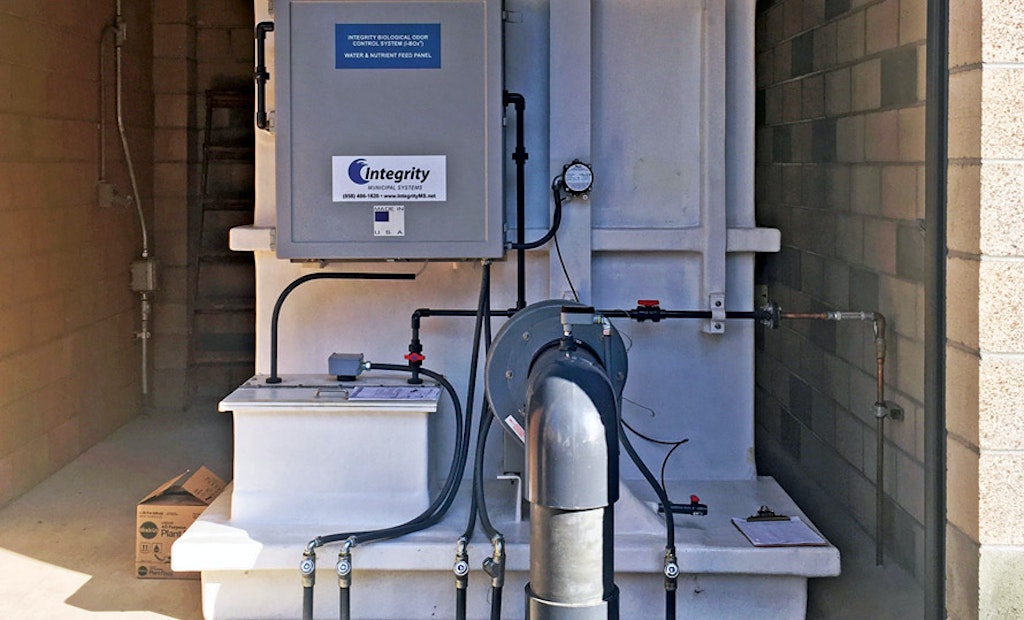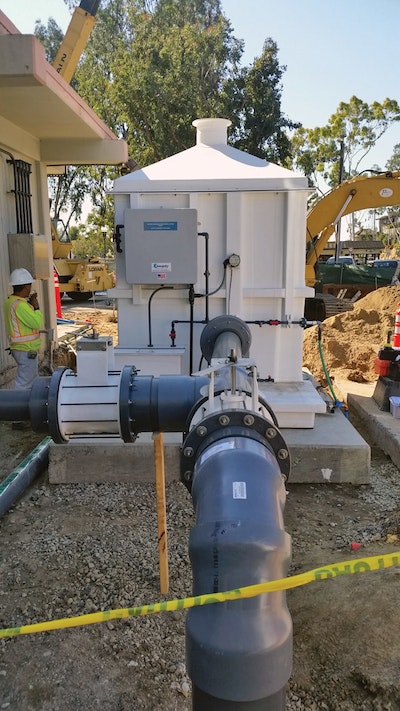
The I-BOx 6000 odor-control system (shown here at the Bluebird Lift Station) has provided reliable odor control for the City of Laguna Beach.
Interested in Odor Control?
Get Odor Control articles, news and videos right in your inbox! Sign up now.
Odor Control + Get AlertsLaguna Beach is a small California community of beaches, hiking trails, a walkable downtown, and summer art festivals.
Laguna Beach occupies 8.84 square miles in southwest Orange County, has a population of 23,000, and welcomes some 6 million visitors each year. Services include recreational activities and cultural arts events. The sanitary sewer system incorporates 85.71 miles of gravity sewers, 9.44 miles of force mains, 25 lift stations and 2,674 manholes.
In recent years, the city has installed biological odor-control systems to eliminate odors and community complaints at three major wastewater lift stations.
Reviewing alternatives
The Laguna SOCWA Lift Station, built in 1981, is the city’s second largest and pumps about 1 mgd of wastewater, first to the Bluebird Lift Station and then on to the Coastal Treatment Plant in Laguna Niguel. After decades in service, the wet well at the Laguna SOCWA station became dilapidated, requiring a full reconstruction in 2016. Because odors around the lift station had been a nuisance, a long-term odor-control solution was included.
When evaluating options, the city reached out to odor control consultant, Donald King, P.E., of DHK Engineers. King considered safety, reliability and cost in making a recommendation. Aesthetics was also a factor, as it was imperative that the system have a compact footprint and a low vertical profile, and that it be screened from view while allowing proper dispersion of the scrubber exhaust.
City leaders wanted a system using no hazardous chemicals, with minimal moving parts and low noise. They also wanted flexibility to handle high and low influent hydrogen sulfide odor profiles, as well as other odorous organic compounds. A plug-and-play system would allow for minimal on-site construction and commissioning activities.
The city ultimately selected the I-BOx 6000 biological odor-control system from Integrity Municipal Systems for meeting the requirements with minimal operating and maintenance costs. The system requires only off-the-shelf, locally available additives and no proprietary products; the supplier offered a clearly defined scope of services, a strong warranty and initial operating service.
“The IMS team has a track record for over 30 years of doing whatever it takes to resolve any issue, even if not directly connected to the IMS equipment,” King says. “They are a highly knowledgeable team in all aspects of odors, control technologies, ventilation and air permitting.”
Ready to run
The system was pre-assembled, piped, wired and tested in the IMS factory to enable fast installation and startup. The packaged biological system includes an air exhaust fan and odor-control vessel made of fiberglass-reinforced plastic, a water and nutrient feed panel, a nutrient tank, and an electrical control panel. All components are mounted on the low-profile vessel deck for easy access and maintenance. The control panel is remote-mounted on a wall next to the odor-control system and outside the hazardous Class 1, Division 2, Group D area.
The fan in the packaged, once-through system continuously pulls the odor-laden air from the wet well and surrounding manholes into the odor-control system for treatment before release to the atmosphere. There are two treatment stages:
Stage 1
The biological process stage removes primarily hydrogen sulfide by providing an environment that promotes the natural growth of acidophilic, sulfur-oxidizing bacteria. The media is an inert, porous, mineral-expanded clay designed to resist compaction and degradation from the acidic sulfates created by the biological oxidation of the hydrogen sulfide.
This stage operates with an independently controlled irrigation system to provide the media with enough moisture to sustain bacterial growth and remove toxic byproducts. Irrigation is controlled by a programmed timing sequence that actuates a solenoid valve on the water-supply piping. Nutrients are trickled down over the media to enhance and sustain the biological activity. The nutrients are housed in an integrated tank and are dosed by a pump mounted in the water and nutrient feed panel.
Stage 2
A second-stage pelletized coal activated carbon media removes any remaining hydrogen sulfide and other odorous organic compounds, polishing any sharp hydrogen sulfide spikes that break through Stage 1. The cleaned air is discharged through a stack at the top of the unit.
Fast results
While the odor-control system was being manufactured, IMS within a few days delivered two temporary activated carbon adsorber systems. They were immediately deployed at the wet well and the manhole, protecting the nearby business community from odors.
After a contractor installed the biological system, IMS performed commissioning and operator training. While the city had seen well over 100 ppm of hydrogen sulfide in the wet well before installation, the new system recorded 10 ppm at the inlet and 0 ppm at the outlet, solving the odor problem with a reliable, efficient, cost-effective, and sustainable technology.
“The IMS team is highly experienced and provided dedicated customer service every step of the way,” says Hannah Johnson, project manager for the city. “Installation and commissioning went seamlessly. We’ve received positive feedback from members of the community about how much the unit has improved the nuisance odors.”
More applications
Based on the success at the Laguna SOCWA Lift Station, the city applied the same solution to the Bluebird SOCWA Lift Station, about 1 mile away. As the city’s largest lift station, it conveys all wastewater within the city’s service boundaries — about 2 mgd — to the Coastal plant at Laguna Niguel.
Built in the early 1980s, the Bluebird station had a long history of odor complaints. The I-BOx 6000 system was installed there in November 2019. Testing after startup showed an average hydrogen sulfide loading of 15 ppm and a peak of 229 ppm at the inlet and none detectable at the outlet. Inlet and outlet gas samples analyzed by an accredited testing laboratory confirmed the system’s performance.
The city turned to IMS again to address odor concerns at the Victoria Beach Lift Station. The city selected the MCS carbon adsorber system, a single-stage, skid-mounted, dry-media system, designed for relatively lower odor levels and organic odors. The media can be virgin activated carbon or any of a number of specialty catalytic carbon media.
Johnson states, “We’ve purchased several odor control units from IMS and have had great success with every installation.”






